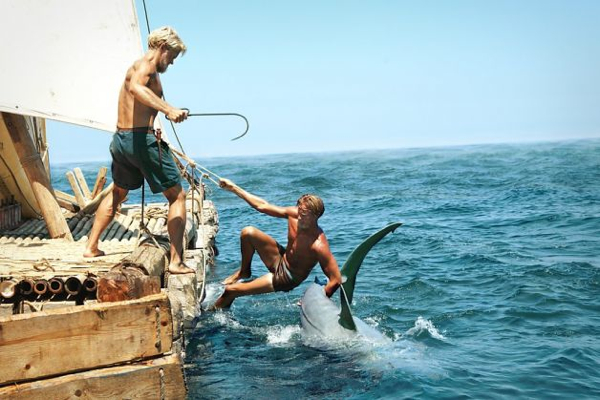Movie review by Greg Carlson
A fictionalized account of Thor Heyerdahl’s 1947 seafaring adventure, “Kon-Tiki” burnishes Heyerdahl’s well-documented penchant for mythmaking and self-promotion. Nominated for an Oscar in the Foreign Language category, “Kon-Tiki” was shot in both Norwegian and English editions, and most U.S. viewers will experience the latter as the Weinstein Company’s release rolls out to American cinemas. Heyerdahl’s theory, that people from what is now Peru may have traveled to and populated Polynesian islands, was not then and is not now believed by most anthropologists, but the spirit of exploration and not the scientific record really fuels the movie.
Culling together material from Heyerdahl’s wildly popular book “The Kon-Tiki Expedition: By Raft Across the South Seas” and the Academy Award-winning documentary that remains Norway’s only Oscar-winning feature to date, “Kon-Tiki” tempers the long stretches of uneventful downtime with sudden bursts of intense conflict and crisis. Spending the majority of its duration on the water journey itself, “Kon-Tiki” also covers Heyerdahl’s initially unsuccessful attempts to mount the unlikely Pacific Ocean crossing on a raft of balsa logs lashed together. A minor subplot addressing marital tension between Thor and his wife Liv adds another small layer of drama.
Weirdly, directors Joachim Ronning and Espen Sandberg feel compelled to punch up a few of the voyage’s key moments with outright fabrications. Perhaps the most glaring example is the demise of parrot mascot and companion Lorita, who, according to Heyerdahl’s original documentary, simply took wing some sixty days into the adventure, never to be seen again. This time, Lorita is snapped up by a hungry shark, setting the stage for a brutal man-versus-nature slaughter fueled by the rage of a bereaved crewmember. By all accounts, however, the presence of sharks was constant, even if the movies, thanks to “Jaws,” can’t resist showcasing the animals as ultimate, primal fear-inducing predators.
A source of consternation for family members (none of the original Kon-Tiki crew are alive today) of German-born Herman Watzinger is the film’s portrayal of the refrigeration engineer. As Heyerdahl’s second in command, the real life Watzinger was confident of the raft’s seaworthiness, but the movie uses Watzinger to manufacture conflict that did not genuinely exist. Actor Anders Baasmo Christiansen is asked to play a nervous, out-of-shape doubter whose actions veer close to the edge of endangering the lives of his fellow sailors. “Kon-Tiki” screenwriter Petter Skavlan has defended the changes, but the result is diminished credibility.
“Kon-Tiki” might inspire more visits to the excellent museum in Oslo where the original raft is housed (along with Heyerdahl’s Oscar statuette). In the end, the successful completion of Heyerdahl’s mission at least validated the claim that a 4000 plus nautical mile journey on little more than a bobbing cork was possible. Considering the manner in which the filmmakers have defended their “enhancements” to Heyerdahl’s story, however, “Kon-Tiki” surely would have been improved by the inclusion of a more idiosyncratic and self-aware tone. The film takes itself very seriously when it could, and probably should, be playing with the captain’s oddness, ego, and self-righteousness.
